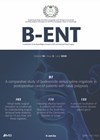
Journal Reviews
Assessment of temporal bone skills on 3D-printed temporal bones – a useful training curriculum?
The authors contend it is now archaic to follow Halstead’s model of surgical training, namely ‘see one, do one and teach one’. Simulated training is now widely used in many surgical specialities. With every surgical trainee having an individual learning...
Endovascular therapies for venous tinnitus
Tinnitus is an extremely vexing issue, not only for patients but also for otolaryngologists. The authors of this article review the causes of venous tinnitus, such as increased intracranial hypertension (IIH), dural venous sinus thrombosis and age-related anatomic variants. They...
Reduction in recurrent cholesteatoma rates with bony obliteration tympanoplasty technique
This large retrospective study from the Erasmus Medical Centre in Rotterdam compares outcomes in traditional canal wall up (CWU) and canal wall down (CWD +/- partial obliteration of mastoid bowl) mastoid surgery for cholesteatoma with bony obliteration tympanoplasty (BOT, which...
Further understanding of GJB2 hearing loss
For many years, hearing loss has been an area which has attracted the interest of clinical and academic geneticists. Genetic testing for severe-profound hearing loss is now commonplace in many healthcare systems. Understanding the genetics of hearing loss has improved...
Can amplification preserve auditory function?
Hearing loss is a noted modifiable risk factor for dementia, and is also associated with depression, decreased quality of life and isolation. Hearing aids are the main intervention for presbycusis and a 2017 Cochrane Review showed that they have a...
Surgery safety checklists
The time-outs were based on pre-flight checklists adopted by airline pilots and were instituted in all accredited hospitals and ambulatory care centres in the United States in 2003. The guidelines originate from general surgery and are not specific for the...
Management of postoperative cholesteatoma
This prospective longitudinal observational study compared the ability of second-look surgery with that of surveillance using serial non-echo-planar diffusion-weighted imaging to detect residual cholesteatoma after canal wall-up mastoidectomy. A total of 34 patients were included in the study who underwent...
Hyperbaric oxygen therapy a treatment for sudden sensorineural hearing loss
Cochlear ischaemia has been postulated as one of the potential aetiologies for sudden sensorineural hearing loss. Hence, increasing oxygen delivery to the cochlea by hyperbaric oxygen therapy has been explored as a potential treatment to reverse hearing loss. The authors...
Is endoscopic approach more precise in addressing failed ventilation system in chronic mucosal ear disease?
Chronic mucosal disease, as opposed to cholesteatoma, is more directly related to failure of the ventilation system involving three channels. Isthmus anticus and isthmus posticus are channels in front and behind the long process of the incus and there is...
Hydrogen peroxide and its uses in healthcare
This is an interesting review about the origin and uses of hydrogen peroxide, especially in neurosurgery. However, its uses are ubiquitous and applicable to several medical specialties. When hydrogen peroxide was first discovered in 1818 by Louis Thenard, it had...
Does Koos classification predict facial nerve dysfunction?
The Koos classification is a grading system used often for preoperative evaluation of acoustic tumours on imaging studies. It indirectly correlates to the size of the tumour. Size of the vestibular schwannoma is often considered the main determinant for hearing...
Compress to suppress the venous tinnitus
This interesting retrospective case series analyses the effectiveness of a modified surgical technique with retromastoid reconstruction of the sigmoid sinus by mechanical compression with Surgicel and bone wax packing under local anaesthesia for patients with venous pulsatile tinnitus related to...

















